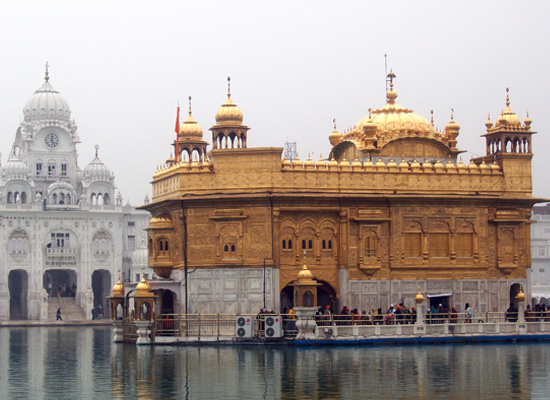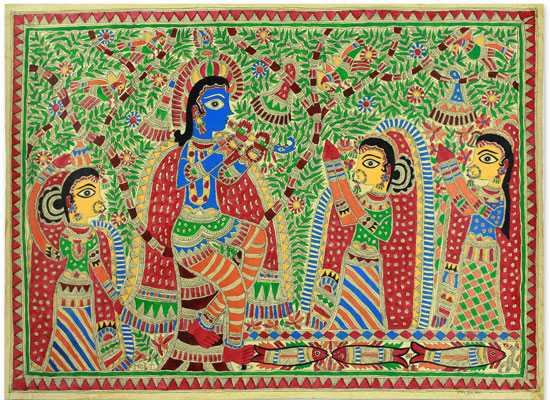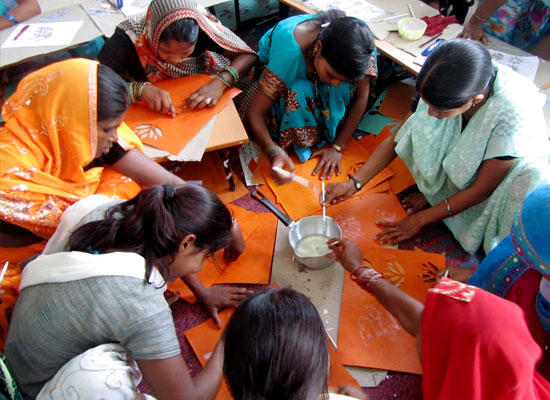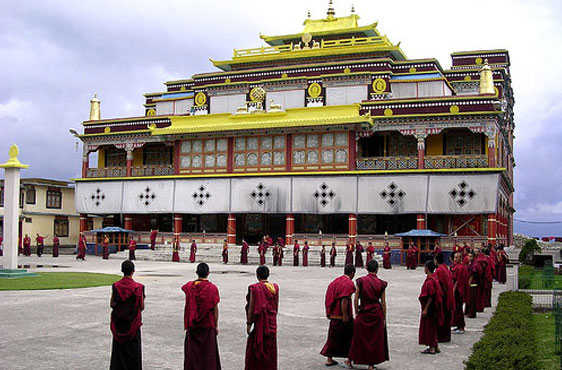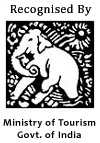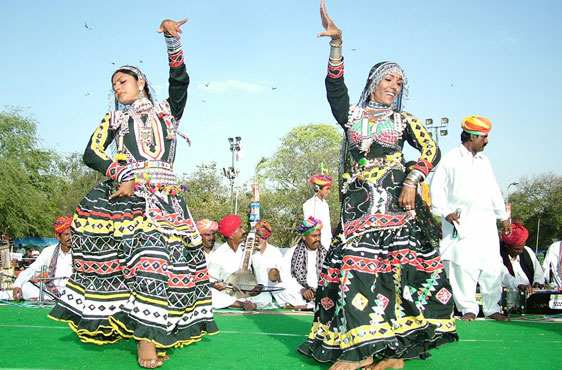
Since ancient times, India has been mentioned in glowing terms as the epitome of culture, heritage, and tradition. Multifaceted culture and heritage of India, in true way, is the biggest asset of the country all prevailing since earliest civilization and continuous since the period of rulers such as, Rajputs, Mughals, English, and Portuguese. Besides this, the country also is potent cauldron of different religions and heritage prevalent since the time of these rulers. Blissfully, India still preserves its rich culture and heritage in several of its forms like arts, crafts, religion, philosophy and tradition.
It doesn’t matter when tourists visit India, the diversity prevailing in the country, therefore, offers its tourist an array of options. Cultural tourism in India has always attracted tourists from all over the world. It includes various facets like architectural heritage, food, festivals, religion, languages, fashion, dance, and music.
Architectural Heritage : The different monuments and temples in the country reflect the architectural heritage of this great country. There are a variety of temples built during the ancient times. Some of these are Jain temples, Khajuraho temples, and temples of southern India. The famous monuments Taj Mahal, India Gate, Qutub Minar, and Red Fort, etc are of architectural marvel.
Food : Indian food presents a range of taste, spices, ingredients, and flavours. Some of these are Mughlai, Kashmiri, Goan, South Indian, Punjabi, and Rajasthani.
Festivals : India being a land of different religions, various festivals are celebrated throughout the nation. Some of these festivals are – Diwali, Holi, Christmas, Bakr Id, Easter, and Pongal. Tourists usually visit India during the festive season to be a part of the colourful festivities that are a part and parcel of each and every festival. For example, Pushkar fair in Rajasthan is quite popular among tourists. Similarly, Goa’s carnival season also attracts many tourists from all over the world.
Dance and Music : Indian dance and music are famous all over the world for their unique style and movements. Some of the famous dances are – kathak, mohiniattam, and kathakali. Indian music includes a variety of music from different states. These include Hindustani and carnatic music.
Exploring the different parts of the country through cultural tours in India leaves an everlasting memorable experience for the tourists. India is surely one incredible land!!
10 Days - Customizable
Delhi – Jaipur - Agra – Khajuraho – Varanasi.
DELHI : The history of Delhi, the capital of India, goes back to 3000 years. Various rulers built eight successive cities in and around present day Delhi. Few capitals in the world have as many monuments of which Delhi is justly proud. Capital to seven different cultures over the course of its history, Delhi is a fascinating fusion of them all. The art and architecture reflects its ancient and multifaceted heritage. A Hindu fortress, Mughal tomb, Islamic minaret and mosque are examples of the cultural richness of this city.
Explore Old Delhi, beginning with a drive pass the Red Fort, seat of the Mughal Empire. It is a huge fort, housing within its precincts, imposing palaces and impressive public buildings. Enjoy a Pedi cab ride around Chandni Chowk (an old shopping street). See Jama Masjid, which means Friday mosque. It was built in 1656 and is the largest and the most splendid mosque in India. On to visit the gardens of the Bahai Temple, completed in 1986. It is set among pools and gardens and adherents of any faith are welcome to visit and pray or meditate according to their religion. The structure is in lotus shape so it often called the Lotus Temple. Also see Raj Ghat, a memorial to the great Mahatma Gandhi. Visit the Crafts Museum, a collection of traditional Indian crafts in textiles, metal, wood and ceramics. Then see the Temple of the Sikh, Gurudwara.
Also visit New Delhi designed in 1911 by the British, and one of the greenest Capitals in the world. See the impressive Qutab Minar, a 234 foot high red sandstone minaret. The buildings date from the onset of Muslim rule in India. Visit Humayun’s tomb, built in the 16th century, a predecessor to the famous Taj Mahal. Continue past the government buildings and Rashtrapati Bhawan (Presidential Palace) along the broad and majestic Rajpath.
JAIPUR : The rose pink capital of Rajasthan, is surrounded on all sides by rugged hills. The city was founded in 1727 by the astronomer king, Sawai Jai Singh II and built according to the Shilpa Shastra, the ancient Hindu treatise on architecture and sculpture. It is a walled city with seven rectangular blocks. The Maharajahʹs palace stands in the centre of the city amidst lovely gardens.
The excursion takes you to Amber Fort. Riding on elegantly caparisoned elephants, approach the palace in the traditional way. The high gateways allow us to enter on these broad backed animals. Amber was once the ancient capital of Jaipur. Construction of the fortress palace started in 1592 by Raja Man Singh, the Rajput Commander of Akbar’s army. It was later extended and completed by the Jai Singh. The fort is a superb example of Rajput architecture, stunningly situated on a hillside and over‐looking a lake which reflects its terraces and ramparts.
Explore Jaipur visiting Jantar Mantar, an observatory equipped with instruments of astonishing size and precision, including a 90 foot high sun dial. See the Hawa Mahal or Palace of Winds, a major Rajput landmark built in 1799. This five story building in the old city; is a pink sandstone masterpiece with semi octagonal and delicately honeycombed windows. The monument was originally conceived to enable ladies of the royal household to watch the city’s everyday life and royal processions in absolute privacy. The City Palace is the royal residence of the erstwhile King of Jaipur. It houses a museum with a superb collection of Rajasthani costumes, armoury of Mughal and Rajput weaponry, and swords of different shapes and sizes with ornamental handles – some of them inlaid with enamel, embellished with jewels and encased in magnificent scabbards. Continue past Moti Doongri Palace – a privately owned hilltop fort built like a Scottish castle – to Ram Niwas Gardens and architecturally impressive Albert Hall.
FATEHPUR SIKRI : The once fabled Mughal capital has taken on a sleeping beauty quality, lying quietly but wonderfully preserved. The Emperor Akbar built Fathepur Sikri during the second half of the 16th century; Fatehpur Sikri (the City of Victory) was the capital of the Mughal Empire for only some ten years. The complex of monuments and temples, all in a uniform architectural style, includes one of the largest mosques in India, the Jama Masjid. A large number of masons and stone carvers worked hard on an area that was over two miles long and a mile wide. They used brilliant red sandstone available locally, which provides the buildings with much of their lustre. Shortly after the work was completed fifteen years later, it was realized that there was a lack of an adequate water supply and the pristine complex was abandoned.
AGRA : The earliest reference to Agra is in the epic, the Mahabharat. It was, however, in the medieval period that Agra earned prominence as a capital city under the Mughals. Its many wonderful monuments and the Taj Mahal, the greatest of them all, have given it a unique position as a major tourist centre. The Taj Mahal, simply, is beauty not just in design and technique, but also in desire and intent. It was built as a monument to love, a manifestation of life’s most powerful emotion. When his wife died unexpectedly, Emperor Shah Jahan vowed to honour her with a memorial of unmatched beauty. A delicately carved, white marble jewel, which seems to float on a sea of red limestone, the Taj Mahal generally considered the finest example of Mughal architecture; became a UNESCO World Heritage Site in 1983.
Also visit the important 16th century Mughal monument known as the Red Fort of Agra. This powerful fortress of red sandstone encompasses, within its 2.5 km long enclosure walls, the imperial city of the Mughal rulers. It comprises many Fairy tale palaces, such as the Jahangir Palace and the Khas Mahal, built by Shah Jahan; audience halls, such as the Diwan-i-Khas; and two very beautiful mosques.
KHAJURAHO : Spread over an area of approximately 20 square kilometers on the north eastern part of Madhya Pradesh, Khajuraho is a major tourist and archaeological site. In the temple architecture of India, the Khajuraho complex remains unique. One thousand years ago, Khajuraho temples, at times referred to as the Kamasutra temple were built under the generous and artistic patronage of the Chandela Rajput kings of Central India. Renowned for its sculpture and the sexually explicit carvings both inside and outside, the temples are dedicated to Shiva, Vishnu, and Jain deities. Today, of the original 85, only 22 have survived the ravages of time; these remain as a collective paean to life, to joy and to creativity; to the ultimate fusion of man with his creator.
A day trip to Orchha : Orchha's grandeur has been captured in stone, frozen in time, a rich legacy to the ages. In this medieval city, the sand of time has rested lightly and the palaces and temples built by its Bundela rulers in the 16th and 17th centuries retain much of their pristine perfection.
VARANASI : Varanasi is without doubt India’s most sacred city and thus visited by over one million people. It is also called the city of light. Buddha visited this city in 500 BC.
One can start a day with a boat ride on the holy river Ganges and enjoy sunrise on the boat. Ghats (flight of steps) and the activities of pilgrims on that are the principal attraction for visitors to Varanasi. Thousands of pilgrims and devotees visit this city to make holy prayers, to meditate and to purify themselves through taking a bath in the holy river Ganges.
A visit to Sarnath, the place where Buddha delivered his first sermon at deer park is also included in the tour.
Accommodation in pre checked and approved guest houses, home stays and 4 star hotels.
Students must show proof of medical coverage while overseas.

